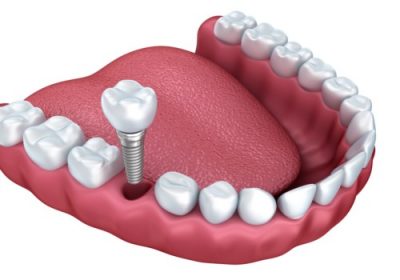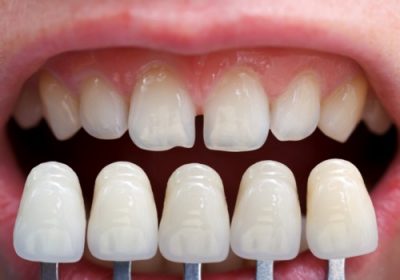Are you trying to choose between implants and veneers? Remarkable improvements to your smile will be visible by using either option. However, there are certain differences between these aesthetic treatment options and it can influence whether you decide to pursue one or the other. We can offer both options of these treatments to our esteemed patients. We also want you to have all the relevant information before you decide on either of these options.
Which Option Is Best for You?
Both the procedures have their merits and problems. It will be your aesthetic, operational, and financial priorities which will play an important role in your decision.

Dental Implants?

They are the most advanced and popular route in utilitarian and aesthetic dentistry. It is a replacement for a tooth root which is created to be as firm as a current root and in certain cases the bond could potentially become even stronger. It is a threaded post of titanium alloy twisted into the jaw bone. After approximately 3 to 6 months they will meld into the jaw. It becomes part of the body by the process of osseointegration. Attaching a single porcelain crown over it can help to retain it for long. Read more about dental implants.
Veneers?

They are thin caps with a thickness below half a millimeter manufactured from porcelain or other composite material. They are available in different colors and shades to match the existing color in your mouth. They are normally implemented on the front teeth but can also be used on the upper and lower or both sets of teeth in certain situations. This solution is appropriate for covering any damaged or cracked teeth. They are made from porcelain are translucent and can bring back the natural appearance of the teeth to your mouth. If you have stained teeth you can have colored veneers administered concealed cement. Learn more about Veneers.
Standard Procedure
The conventional procedure is slightly longer and will typically involve multiple visits between a period of 3 to 6 months. However, you can remain unconcerned about any painful situations because the procedure by itself is unlikely to hurt or cause any pain. It must be performed under local anesthesia and the procedure will be as follows:
- Consultation And Examination — When beginning the process consultation and examination is an essential step. You will have a discussion with your dentist about your precise requirements during your first visit. Your dentist will take a comprehensive look at your medical as well as dental history. An examination of your mouth orally will be conducted for determining your current oral health. 3-D x-ray images of your jaw will also be examined to understand the condition of your jawbone. This is extremely important because the jawbone needs to have the strength for supporting the artificial tooth and also be capable of bearing the chewing forces transmitted when eating.
- Extraction Of Existing Teeth — If the prognosis of your existing teeth is pessimistic they will be removed from the jaw. Thereafter the gums are provided enough time to heal.
- Grafting — If deficiencies are noted in the jaw bone or gum flesh grafting on both is a possibility which must be considered. Likewise grafting of the gum flesh may also become necessary for improving aesthetics. As grafting is a surgical procedure three months should be allowed for recovery after grafting.
- Installation Of the false tooth — After bone growth is considered satisfactory holes are drilled into the structure with speed-controlled drills and precalculated positions and angulations. The implants are thereafter fixed on an abutment which assists the artificial teeth later on. The gum flesh is sutured over and the patient is allowed to go home for osseointegration which may require 3 to 6 months.
- Placement Of Crowns — After the natural occurrence of osseointegration takes place the next visit to the dentist will be proposed. Specially created crowns will be attached with the help of abutments. In conditions where all the teeth are being replaced the entire set of 14 teeth can be supported by four appropriately located and angulated implants. These are popularly called ‘all-on-four.’
Same-Day Implants at Highland Oak Dental
If you wish to avoid a lengthy delay before you get an opportunity to show off your beautiful new smile you can rest assured you will not be disappointed. Dentists have evolved and are now providing a same-day treatment to restore you smile within hours. They are loaded with a crown, denture, or bridge immediately after being placed inside the jawbone.
How it is applied?
The application of the procedure is relatively fast although the procedure must be conducted by a skilled dentist. Generally, you will need to visit your dentist a couple of times. The dentist will make an impression of your teeth during the first visit to forward them to the laboratory for manufacturing. You will have an opportunity to choose the color, shade, and type of material which your dentist will forward the laboratory. Your choice of material will determine the cost of the procedure. Your next visit to the doctor will only be scheduled after the solution are manufactured. The teeth will then be prepared for the veneer is to be bonded onto them.
How Does Osseointegration Help To Ensure Success Of the Implant?
Not all types of restoration in modern dentistry is similar to this effect. When titanium implants are fashioned into living bone, the bone cells will begin growing into the surface. It takes typically six months to set nd integrates itself with the bone to form a firm and natural bond.
Where are the benefits?
They are beneficial for dealing with aesthetic problems and concerns of the following types:
- Stained permanent teeth.
- Teeth with gaps.
- Chipped teeth.
- Teeth with cracks.
- Crooked of deformed teeth.
Using the help of this technique can help you to have your shining smile back in no time at all.
What Are The Benefits?
- Long Life — They can be considered as a lifetime asset. They can last for over two decades, making them a worthwhile investment.
- No deterioration — The chances of discoloration, cracking or dislocation are eliminated when porcelain teeth and placed.
- Osseointegration — Implants are created by using titanium material and therefore have the unique property of osseointegration or integration with the bone. This provides the strength, reliability as well as longevity.
- Becomes Part of the Body — Implants by osseointegration are not similar to veneers because they become a part of the body.
- Additional Care Is Not Required — It does not restrict you by posing any limitations and provide you the freedom to have the foods you want without holding you back with the fear of taking special care other than regular oral hygiene.
- No Caries-No Gum Disease — These artificial teeth are not susceptible to decay.
- Full Mouth Treatment — Implants can also be used for full mouth rehabilitation in a single jaw.
Limitations
Despite being a fantastic option are associated with some shortcomings. Here are some of the major shortcomings which can cause concern among users.
- Impossible to Make Tooth Replacements — They are the best option for cosmetic purposes and for restoring Crooked and chipped teeth.
- Limited lifetime — The typical lifetime of this is about 10 years and thereafter they must be replaced.
- Cracks — There are cases of cracks especially when they have not bonded appropriately during the initial procedure.
- Dislocation — When veneers are improperly bonded they may shift and recede from the gum line giving rise to tooth decay and gum disease.
What Are Your Choices?
We have provided you sufficient information about both the treatments. You would have understood that implants despite their higher costs are unmatched in terms of their aesthetics, convenience, and durability. Therefore should you be waiting any longer before making a decision? Set up an appointment with one of our experienced dentists to understand what we can do to bring that beautiful smile back to your mouth.
